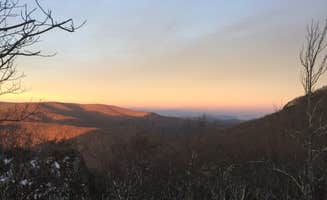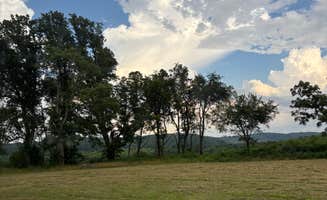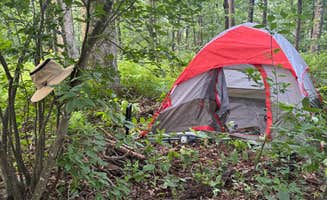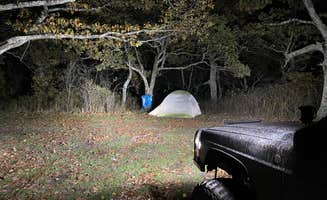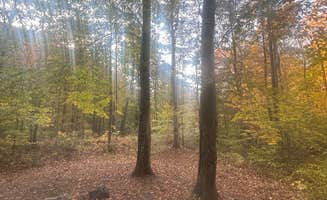Dispersed camping in the George Washington National Forest around Afton, Virginia offers primitive options in the Blue Ridge foothills. At elevations ranging from 1,000-4,000 feet, these areas experience significant temperature drops at night even during summer months. Most campsites require driving on unpaved forest roads that can become difficult to navigate after heavy rainfall.
What to do
Hiking to viewpoints: At Spy Rock, campers can enjoy spectacular mountain vistas after a moderately difficult 1.5-mile uphill hike. One visitor noted, "You hike in and there is a decent sized area to set up tents. Scramble up to the top for amazing sunsets and sunrises."
Rock scrambling: The boulder formations at Spy Rock offer natural climbing opportunities for all skill levels. "This is a great hike with a small rock scramble at the top for an extra bit of fun," explains one camper, adding that "the top has almost 360 degree views of the Shenandoah Valley."
Fishing opportunities: The stocked waters at Braley Pond provide excellent fishing conditions, particularly in spring. A camper mentioned, "The pond is stocked with trout in season, check DGIF site for dates."
Creek exploration: Several camping areas feature small streams perfect for wading and cooling off. One visitor to Braley Pond shared, "We did wade the stream, which was cold and clear and beautiful."
What campers like
Isolation from crowds: Many campers appreciate the solitude found at these dispersed sites. A visitor at James River Wildlife Management Area reported, "I never saw another person camping, but I did get out of my rig and ask a couple of people that were using brush hogs to mow with and they said Yep come on down here and just park wherever you want to."
Star visibility: The minimal light pollution creates exceptional stargazing conditions. One camper at George Washington National Forest off 812 enthused, "The stars were amazing! There was plenty of wood scattered about to use as firewood."
Convenient central location: The strategic position between major regional attractions makes these sites practical base camps. A visitor noted it's "great for when you need a place in central Virginia to camp."
Natural soundscapes: The sound of running water enhances many camping experiences. A camper at George Washington National Forest off 812 appreciated that their site was "clean, creek for water if you have filter. Nice fire ring and wood."
What you should know
Accessibility challenges: Many sites require appropriate vehicles or hiking capability. A camper at Flagpole Knob warned, "This site requires a 4x4 vehicle with clearance. The trail leading to and from camp can be a bit tricky for some."
Seasonal considerations: Weather patterns significantly impact site conditions throughout the year. One visitor observed, "This area is fairly low, and the road and sites can easily be soaked, if not underwater after really heavy rains."
Cell service limitations: Most areas have minimal or no connectivity. A camper noted, "There is no cell signal here (at least with Verizon as of 3/2020)."
Wildlife encounters: Bears and other wildlife frequently visit camping areas. At Laurel Prong Trail, campers reported, "Bears were constantly checking out our tent during night... 100% do not have food scents near your tent."
Tips for camping with families
Picnic areas with facilities: For families with young children, day-use areas provide convenient amenities. A visitor to Braley Pond shared, "I brought my boys out to camp this past weekend, and this place was perfect for our first dispersed campsite experience. The day use area is close enough to use the bathroom (just an open pit toilet, nothing fancy)."
Kid-friendly water features: Small streams provide natural play areas for children. One parent mentioned, "Though you can't swim in the lake, we did wade the stream, which was cold and clear and beautiful."
Educational opportunities: The diverse ecosystems support wildlife observation and nature study. A camper noted, "There are also trails along the pond's edge. we didn't explore too in depth, so there may be more hiking available."
Flat camping areas: Some locations offer level ground that simplifies tent setup with children. A visitor to Reservoir Road appreciated the "nice camping spots on the pedlar river in Amherst county. Multiple spots along reservoir rd."
Tips from RVers
Road condition assessment: RVers should scout roads before attempting access with larger vehicles. One camper at Switzer Lake Dispersed Camping advised, "The road is a mix of gravel but also dirt so it can become muddy during rain."
Parking alternatives: When deep forest roads prove impassable, consider parking at entrance areas. An RVer at James River Wildlife Management Area explained, "For me being in the 29 foot classy, I opted to park it in a field/parking area at the entrance."
Site selection strategy: Check multiple potential camping spots before committing. A camper suggested, "Take it slow and most vehicles can get by. Where boots and run in to check out the various sites."
Turnaround space: Many forest roads lack adequate space for larger vehicles to turn around if needed. One resourceful RVer shared, "Don't use me as an example, you definitely should not drive your 2018 Ram ProMaster 2500 159 wb campervan up that road like I did."


